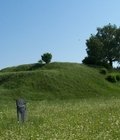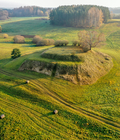The mound dates back from the the end of the 1st millennium BC to the 1st millennium AD. It is located northeast of Gaigaliai village, on the eastern edge of Šepeta swamp. The mound was described by Ludvikas Kšivickis in the beginning of the 20th century, and by Petras Tarasenka in 1943. The exploratory archaeological research of the mound was carried out by the Lithuanian Institute of History in 1969, and the mound was studied by archaeologists of the Council for the Scientific Methodical Protection of Cultural Monuments in 1971 and 1980. An ancient settlement was discovered at the northern and southwestern foothills of the mound in 1980. Two parts of clay spindles in the form of a double truncated cone, shards of molded pots with polished and roughened surfaces, decorated with pinched ornaments were found. The finds are kept in the National Museum of Lithuania. After exploring the terrace of Gaigaliai mound in 1989, it became clear that a protective ditch was dug at the place of the terrace in ancient times, outside of which stood a wooden defensive wall. The mound has long been called Gaidžiokalnis or Gaidžkalnis, because it is believed that people heard roosters crowing on the mound in ancient times. The mound was declared a cultural monument in 1998, and recognized as protected by the state in 2005.

+2











Reviews